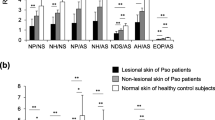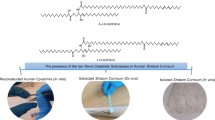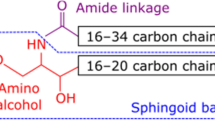Abstract
Ceramides are sphingolipids consisting of sphingoidbases, which are amide-linked to fatty acids. In the stratum corneum, they represent the major constituent of the free extractable intercellular lipids and play a significant role in maintaining and structuring the water permeability barrier of the skin. Using thin layer chromatography, which represents the method of the first choice in analyzing the stratum corneum ceramides, at least seven classes can be distinguished. Each ceramide class contains various species, which have the same head group and different chain lengths. As in many other skin disorders, atopic dermatitis and psoriasis show derangements in content and profile of the ceramides. Such derangements were reported for both the lesional involved as well as for the normal-appearing uninvolved skin. In this study, we focused on investigating the stratum corneum ceramides of the uninvolved skin in atopic dermatitis and psoriasis patients compared to healthy skin. The aim of the investigations was to explore possible significant and specific differences which can be accomplished for purposes of early diagnostics. The skin lipids were collected by means of an in vivo topical extraction procedure using an extraction mixture consisting of n-hexane and ethanol, (2:1). An automated multiple development-high performance thin layer chromatography (AMD-HPTLC) method with photodensitometric detection were applied to separate the ceramides and to estimate their contents. For studying their molecular profile within each ceramide class, a new method of normal phase HPLC with atmospheric pressure chemical ionization mass spectrometry were used. The results obtained by AMD-HPTLC exposed no significant alterations regarding the relative composition of the major stratum corneum lipids and primarily the ceramides. In addition, the mass spectrometric profiles within each ceramide class were similar in the patients and the healthy control subjects. In conclusion, this study revealed that the normal-appearing uninvolved skin of atopic dermatitis and psoriasis patients does not prove significant or specific deficiencies with respect to the free extractable major stratum corneum lipids and mainly the ceramides, when compared to healthy skin. Thus, they cannot be used for diagnostic purposes. Furthermore, our data are not consistent with the concept that impairments in the ceramide composition represent an obligate etiologic factor for both diseases.





Similar content being viewed by others
References
Alessandrini F, Stachowitz S, Ring J, Behrendt H (2001) The level of prosaposin is decreased in the skin of patients with psoriasis vulgaris. J Invest Dermatol 116:394–400
Berardesca E, Fideli D, Borroni G, Rabbiosi G, Maibach H (1990) In vivo hydration and water-retention capacity of stratum corneum in clinically uninvolved skin in atopic and psoriatic patients. Acta Derm Venereol 70:400–404
Bleck O, Abeck D, Ring J, Hoppe U, Vietzke JP, Wolber R, Brandt O, Schreiner V (1999) Two ceramide subfractions detectable in Cer(AS) position by HPTLC in skin surface lipids of non-lesional skin of atopic eczema. J Invest Dermatol 113:894–900
Bonte F, Pinguet P, Chevalier JM, Meybeck A (1995) Analysis of all stratum corneum lipids by automated multiple development high-performance thin-layer chromatography. J Chromatogr B Analyt Technol Biomed Life Sci 664:311–316
Bouwstra JA, Gooris GS, Dubbelaar FE, Weerheim AM, Ijzerman AP, Ponec M (1998) Role of ceramide 1 in the molecular organization of the stratum corneum lipids. J Lipid Res 39:186–196
Charman C, Williams H (2000) Outcome measures of disease severity in atopic dermatitis. Arch Dermatol 136:763–769
Coderch L, Lopez O, de la Maza A, Parra JL (2003) Ceramides and skin function. Am J Clin Dermatol 4:107–129
De Paepe K, Weerheim A, Houben E, Roseeuw D, Ponec M, Rogiers V (2004) Analysis of epidermal lipids of the healthy human skin: factors affecting the design of a control population. Skin Pharmacol Physiol 17:23–30
Di Nardo A, Wertz P, Giannetti A, Seidenari S (1998) Ceramide and cholesterol composition of the skin of patients with atopic dermatitis. Acta Derm Venereol 78:27–30
Downing DT, Stewart ME, Wertz PW, Colton SW, Abraham W, Strauss JS (1987) Skin lipids: an update. J Invest Dermatol 88:2s–6s
Elias PM (1981) Epidermal lipids, membranes, and keratinization. Int J Dermatol 20:1–19
Farwanah H, Neubert R, Zellmer S, Raith K (2002) Improved procedure for the separation of major stratum corneum lipids by means of automated multiple development thin-layer chromatography. J Chromatogr B Analyt Technol Biomed Life Sci 780:443–450
Farwanah H, Nuhn P, Neubert R, Raith K (2003) Normal-phase liquid chromatographic separation of stratum corneum ceramides with detection by evaporative light scattering and atmospheric pressure chemical ionization mass spectrometry. Anal Chim Acta 492:233–239
Fredriksson T, Petterson U (1978) Severe psoriasis - oral therapy with a new retinoid. Dermatologica 157:238–244
Ghadially R, Brown BE, Sequeira-Martin SM, Feingold KR, Elias PM (1995) The aged epidermal permeability barrier. Structural, functional, and lipid biochemical abnormalities in humans and a senescent murine model. J Clin Invest 95:2281–2290
Grubauer G, Feingold KR, Harris RM, Elias PM (1989) Lipid content and lipid type as determinants of the epidermal permeability barrier. J Lipid Res 30:89–96
Hamanaka S, Hara M, Nishio H, Otsuka F, Suzuki A, Uchida Y (2002) Human epidermal glucosylceramides are major precursors of stratum corneum ceramides. J Invest Dermatol 119:416–423
Hanifin JM, Thurston M, Omoto M, Cherill R, Tofte SJ, Graeber M, Group TEE (2001) The eczema area and severity index (EASI): assessment of reliability in atopic dermatitis. Exp Dermatol 10:11–18
Hara J, Higuchi K, Okamoto R, Kawashima M, Imokawa G (2000) High-expression of sphingomyelin deacylase is an important determinant of ceramide deficiency leading to barrier disruption in atopic dermatitis. J Invest Dermatol 115:406–413
Holleran WM, Man MQ, Gao WN, Menon GK, Elias PM, Feingold KR (1991) Sphingolipids are required for mammalian epidermal barrier function. Inhibition of sphingolipid synthesis delays barrier recovery after acute perturbation. J Clin Invest 88:1338–1345
Holleran WM, Takagi Y, Menon GK, Jackson SM, Lee JM, Feingold KR, Elias PM (1994) Permeability barrier requirements regulate epidermal beta-glucocerebrosidase. J Lipid Res 35:905–912
Imokawa G, Abe A, Jin K, Higaki Y, Kawashima M, Hidano A (1991) Decreased level of ceramides in stratum corneum of atopic dermatitis: an etiologic factor in atopic dry skin?. J Invest Dermatol 96:523–526
Ishibashi M, Arikawa J, Okamoto R, Kawashima M, Takagi Y, Ohguchi K, Imokawa G (2003) Abnormal expression of the novel epidermal enzyme, glucosylceramide deacylase, and the accumulation of its enzymatic reaction product, glucosylsphingosine, in the skin of patients with atopic dermatitis. Lab Invest 83:397–408
Jin K, Higaki Y, Takagi Y, Higuchi K, Yada Y, Kawashima M, Imokawa G (1994) Analysis of beta-glucocerebrosidase and ceramidase activities in atopic and aged dry skin. Acta Derm Venereol 74:337–340
Kalinin AE, Kajava AV, Steinert PM (2002) Epithelial barrier function: assembly and structural features of the cornified cell envelope. Bioessays 24:789–800
Kusuda S, Cui CY, Takahashi M, Tezuka T (1998) Localization of sphingomyelinase in lesional skin of atopic dermatitis patients. J Invest Dermatol 111:733–738
Macheleidt O, Kaiser HW, Sandhoff K (2002) Deficiency of epidermal protein-bound omega-hydroxyceramides in atopic dermatitis. J Invest Dermatol 119:166–173
Matsumoto M, Sugiura H, Uehara M (2000) Skin barrier function in patients with completely healed atopic dermatitis. J Dermatol Sci 23:178–182
Matsumoto M, Umemoto N, Sugiura H, Uehara M (1999) Difference in ceramide composition between “dry” and “normal” skin in patients with atopic dermatitis. Acta Derm Venereol 79:246–247
Motta S, Monti M, Sesana S, Caputo R, Carelli S, Ghidoni R (1993) Ceramide composition of the psoriatic scale. Biochim Biophys Acta 1182:147–151
Motta S, Monti M, Sesana S, Mellesi L, Ghidoni R, Caputo R (1994) Abnormality of water barrier function in psoriasis. Role of ceramide fractions. Arch Dermatol 130:452–456
Norlén L, Nicander I, Lundh Rozell B, Ollmar S, Forslind B (1999) Inter- and intraindividual differences in human stratum corneum lipid content related to physical parameters of skin barrier function in vivo. J Invest Dermatol 112:72–77
Ohnishi Y, Okino N, Ito M, Imayama S (1999) Ceramidase activity in bacterial skin flora as a possible cause of ceramide deficiency in atopic dermatitis. Clin Diagn Lab Immunol 6:101–104
Ponec M, Weerheim A (1990) Retinoids and lipid changes in keratinocytes. Methods Enzymol 190:30–41
Ponec M, Weerheim A, Lankhorst P, Wertz P (2003) New acylceramide in native and reconstructed epidermis. J Invest Dermatol 120:581–588
Raith K, Neubert R (2000) Liquid chromatography-electrospray mass spectrometry and tandem mass spectrometry of ceramides. Anal Chim Acta 403:295–303
Raith K, Zellmer S, Lasch J, Neubert R (2000) Profiling of human stratum corneum ceramides by liquid chromatography-electrospray mass spectrometry. Anal Chim Acta 418:167–173
Robson KJ, Stewart ME, Michelsen S, Lazo ND, Downing DT (1994) 6-Hydroxy-4-sphingenine in human epidermal ceramides. J Lipid Res 35:2060–2068
Rogers J, Harding C, Mayo A, Banks J, Rawlings A (1996) Stratum corneum lipids: the effect of ageing and the seasons. Arch Dermatol Res 288:765–770
Signorelli P, Hannun YA (2002) Analysis and quantitation of ceramide. Methods Enzymol 345:275–294
Stewart ME, Downing DT (1999) A new 6-hydroxy-4-sphingenine-containing ceramide in human skin. J Lipid Res 40:1434–1439
Uchida Y, Hara M, Nishio H, Sidransky E, Inoue S, Otsuka F, Suzuki A, Elias PM, Holleran WM, Hamanaka S (2000) Epidermal sphingomyelins are precursors for selected stratum corneum ceramides. J Lipid Res 41:2071–2082
Vietzke JP, Brandt O, Abeck D, Rapp C, Strassner M, Schreiner V, Hintze U (2001) Comparative investigation of human stratum corneum ceramides. Lipids 36:299–304
Weerheim A, Ponec M (2001) Determination of stratum corneum lipid profile by tape stripping in combination with high-performance thin-layer chromatography. Arch Dermatol Res 293:191–199
Wertz PW, Madison KC, Downing DT (1989) Covalently bound lipids of human stratum corneum. J Invest Dermatol 92:109–111
Wertz PW, Miethke MC, Long SA, Strauss JS, Downing DT (1985) The composition of the ceramides from human stratum corneum and from comedones. J Invest Dermatol 84:410–412
Yamamoto A, Serizawa S, Ito M, Sato Y (1991) Stratum corneum lipid abnormalities in atopic dermatitis. Arch Dermatol Res 283:219–223
Zellmer S, Lasch J (1997) Individual variation of human plantar stratum corneum lipids, determined by automated multiple development of high-performance thin-layer chromatography plates. J Chromatogr B Biomed Sci Appl 691:321–329
Acknowledgements
The authors gratefully acknowledge financial support from the Kultusministerium Sachsen-Anhalt, project no. 3364A/0021L. The authors thank Manuela Woigk for excellent laboratory assistance.
Author information
Authors and Affiliations
Corresponding author
Rights and permissions
About this article
Cite this article
Farwanah, H., Raith, K., Neubert, R.H.H. et al. Ceramide profiles of the uninvolved skin in atopic dermatitis and psoriasis are comparable to those of healthy skin. Arch Dermatol Res 296, 514–521 (2005). https://doi.org/10.1007/s00403-005-0551-2
Received:
Revised:
Accepted:
Published:
Issue Date:
DOI: https://doi.org/10.1007/s00403-005-0551-2




